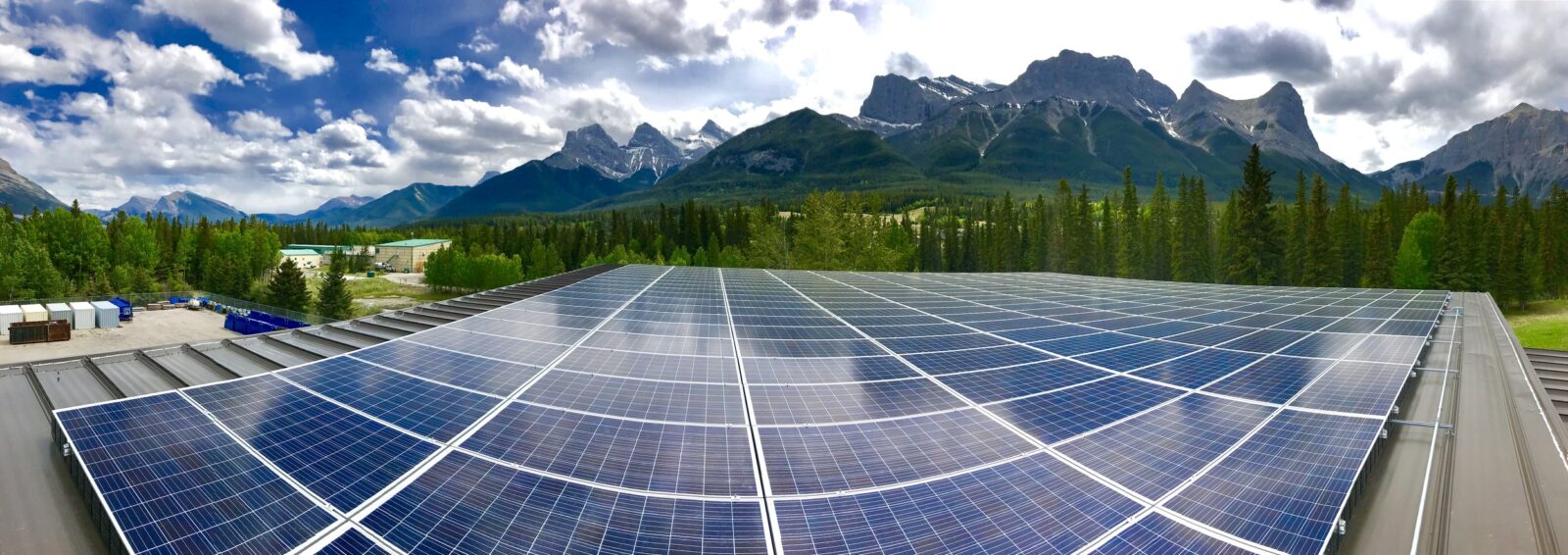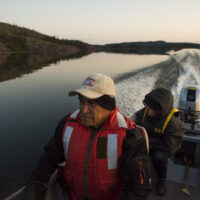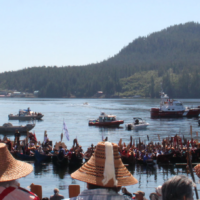This essay was commissioned to inform the research and recommendations in our report Sink or Swim: Transforming Canada’s economy for a global low-carbon future, as part of our Indigenous Perspectives series featuring Indigenous-led initiatives to address and respond to climate change.
I am an Anishnaabe Kwe from Nipissing First Nation, an electrical engineer turned CEO of a business council. I first enrolled in electrical engineering because I wanted to support Indigenous communities to be inclusive participants in the energy sector. While my career has changed in the last few years, my focus is still on enabling inclusive participation of Indigenous communities and businesses, and I still believe wholeheartedly in the opportunity that exists for these communities and businesses in the clean energy transformation that is coming.
Prior to moving to the Canadian Council for Aboriginal Business (CCAB), I managed the First Nations and Métis Relations team at the Independent Electricity System Operator in Ontario from 2014 to 2018. Over those four years, we worked to build requirements to ensure that First Nations and Métis communities in Ontario were active partners in the energy sector. Much of this work happened through renewable procurement. We adjusted policies and program documents to ensure that the procurement of renewable energy was not only accessible to Indigenous communities but also equitable. With each iteration, more communities applied for projects, either as the sole developer or through a partnership. At completion, close to half of the First Nation communities and the Métis Nation of Ontario were partnered on renewable projects through one of those procurements.
The results of our work were very promising, but there was, and still is, a lot more work to be done. There were several communities that wanted to partner or build projects but were not successful due to limited transmission capacity, associates not understanding true partnership or collaboration, or in some cases being constricted by the Indian Act, which limits the control of a First Nation to make decisions about their own land. Had we known all the challenges at the outset, accounted for them in the design, and provided support for communities to be better prepared to respond to procurement opportunities, I am certain that many more communities would by now be generating power for, and revenue from, the grid. Sharing the challenges and feedback from communities can enable community leaders, regulators, proponents, and policy makers in all provinces and territories to accelerate the clean energy transition in ways that support and strengthen Indigenous communities and businesses.
There are still many opportunities for Indigenous partnerships on energy projects and for energy companies to support the growth of the Indigenous economy, both in Ontario and across the country. To be blunt, if proponents, policymakers, and potential partners do not consider Indigenous partnerships or build policies for Indigenous ownership, further development in the clean energy sector will be stalled.
At CCAB, we are seeing the opportunities multiply in this sector. Indigenous communities across the country are building and partnering on projects in the clean energy economy. There are currently over 60,000 Indigenous businesses in Canada, and the Indigenous economy is growing at a significant rate. Over 35 per cent of these businesses are operating in construction, professional, manufacturing, and scientific and technical services—all of which are current participants in the energy sector.
Indigenous communities across the country are building and partnering on projects in the clean energy economy.
Notably, CCAB research indicates that Indigenous Peoples are creating new businesses at nine times the rate of non-Indigenous peoples in Canada, and that Indigenous business owners increasingly recognize the importance of innovation (Canadian Council for Aboriginal Business, 2019). More than six in ten (63 per cent) introduced either new products or services, or new processes, into their business in 2016, up significantly from 49 per cent in 2010 (Canadian Council for Aboriginal Business, 2016). Additionally, there are over 10 energy providers across the country enrolled in CCAB’s Progressive Aboriginal Relations program—demonstrating their commitment to employ, procure, support, and build relationships with Indigenous Peoples.
The interest, the drive, and the businesses are growing, representing an incredible opportunity to meaningfully include Indigenous communities and businesses in Canada’s energy sector and the transition to a clean economy. While several partnerships were built as a result of provincial government policy, we have also seen projects built as a result of corporations righting their past wrongs, such as the Peter Sutherland Generating Station, as well as organizations like NRStor prioritizing building strong relationships with Six Nations of the Grand River on the Oneida Storage project.
Peter Sutherland Generating Station
In March 2017, Ontario Power Generation (OPG) and their partner Coral Rapids Power, a wholly owned subsidiary of Taykwa Tagamou Nation (TTN), completed the Peter Sutherland Sr. Generating Station. The project began with a resolution of the past grievance settlement between TTN and OPG in relation to other OPG hydro projects built in the First Nations’ Traditional Territory. A source of clean, reliable, electricity, the station is located at New Post Creek, about 75 kilometres north of Smooth Rock Falls, within the traditional territory of TTN, who remain 35 per cent equity partners in the station. Named after a respected TTN community elder who passed away in 1998, the station has two units that generate 28 megawatts of renewable, low-cost electricity—enough to power about 28,000 homes. The partnership resulted in more than $50 million in contracts for TTN businesses and about 50 TTN members worked on the project.
Oneida Energy Storage LP
The Oneida Energy Storage Limited Partnership is a joint venture between NRStor Inc. and Six Nations of the Grand River Development Corporation. It is a concrete example of an Indigenous renewable energy partnership with considerable potential to contribute to Canada’s energy evolution. The Six Nations of the Grand River Development Corporation is no stranger to renewable energy and the equal partnership that has been built is a prime example of the benefits of community capacity building. With support from the Canada Infrastructure Bank, Oneida Energy Storage LP and a team of industry leaders are completing a project analysis for what would be the largest energy storage facility in Canada. This project has the potential to provide clean, reliable power capacity by conserving renewable energy during off peak periods and releasing it into the Ontario grid once energy demands reach their peak. In addition, the Oneida Energy Storage LP will create internship opportunities for Six Nations community members and result in training and employment opportunities.
Ontario Renewable Energy Procurement Programs
From 2009 to 2018, Ontario procured renewable energy through two major programs: the Feed-In-Tariff program and the Large Renewable Procurement program.
The Feed-In-Tariff program was introduced in 2009 and went through five iterations. It was a standard-offer program with a set price dependent on the fuel type. Each iteration aimed to keep down the costs to the ratepayer, and to apply feedback and lessons learned from previous procurements while maintaining policy objectives. A priority of the government at the time was to ensure that Indigenous communities were active participants in Ontario’s energy sector. By the last iteration, Feed-In-Tariff 5.0, the following support measures were included to support equal participation of Indigenous communities:
- Security payments, which were required at several points in the process, were set lower for projects controlled by an Indigenous community—to recognize the barriers that communities face to access financing, especially in a highly regulated and high-entrance-cost industry.
- In addition to receiving the standard Feed-In-Tariff price, Indigenous projects received a better price per kilowatt hour proportionate to the amount of equity ownership by the Indigenous community.
- In each procurement, a certain number of megawatts were set aside for projects with greater than 50 per cent Indigenous ownership.
- Priority points were assigned to projects that received a support resolution from the neighbouring Indigenous community or an Indigenous community host.
- An extension was given to the milestone date for operation of projects on First Nation land due to the inability of First Nations to lease land to potential proponents without approval of the federal government.
The Large Renewable Procurement program was introduced in 2013 as a competitive procurement process for projects greater than 500 kilowatts. The program retained many of the similar provisions as the Feed-In-Tariff program. It also included mandatory requirements for proponents to engage with local communities and gave priority to proponents who demonstrated community engagement over and above the mandatory requirements, such as a Band Council Resolution or proof of Indigenous equity participation.
- At the completion of the first round of Large Renewable Procurement, 16 contracts were offered equal to 454 megawatts. Thirteen of those projects had a First Nation partner. Five of them had more than 50 per cent equity participation.
- The successful projects at the completion of the Large Renewable Procurement program saw 15 unique Indigenous communities participating, with two of the projects involving joint partnerships with six remote First Nation communities. The six remote Indigenous communities rely solely on diesel generation and had planned to use the revenue to build clean energy systems in their communities.
As the first Large Renewable Procurement program in Ontario, those are excellent results, but this success was largely due to various iterations and progress made within the Feed-In-Tariff program. An immense amount of progress was due to additional provincial programs that enabled Indigenous communities to build capacity, supporting this growth by covering costs for partnerships and project development. These programs include funding for Indigenous communities to:
- Establish community energy plans through an assessment of options and engagement with their members.
- Support costs in relation to legal and financial requirements to enter into partnerships.
- Support an individual in the community to focus on energy projects and partnerships.
- Support community engagement processes and readiness for future or potential renewable projects.
Unfortunately, with a change in provincial government, a number of those Large Renewable Procurement projects were cancelled. However, there are still opportunities in Ontario and across the country for potential partnerships in transmission, energy storage, and innovative technologies. If I were designing those programs today, I would make three recommendations to any group seeking to foster effective Indigenous partnerships:
1. Build time into the process
It is not enough to incent proponents to partner with communities or vice versa. You need time to build relationships and for communities to discuss the impacts and engage their membership, and it must be built into the process. Meaningful partnerships require trust and relationship building, and we all know that those things take time to develop.
In my own community—which is very well established and has seen considerable economic growth—the decision to use revenues from money held in trust to invest in renewables was made through many community engagement sessions. They were held in person, both off- and on-reserve and online. A decision to move forward was only made once votes were ratified by members. The decision to choose a partner was also made through many in-person community engagement sessions. This was a significant investment of time and money for community staff and elected officials, whose portfolios not only include energy or economic development but most often mental health, education, housing, and elder care as well.
As I said, the Large Renewable Procurement process in Ontario had requirements with respect to engagement with neighbouring communities. Once approved through the request-for-quotes stage, a list of qualified proponents was made public so communities can have some certainty that the proponents are viable partners. However, the feedback received from communities during my time at Independent Electricity System Operator found that although the request-for-proposal process was six to eight months long, many communities reported that they were bombarded with requests to partner in the four-week period before the deadline.
2. Build capacity and ready Indigenous communities for partnership
I heard from many communities that they were not equipped to respond to requests to partner in the timelines the proponents required. While we can continue to assert that proponents must take time to build meaningful relationships, this is extremely difficult to enforce. So how do we better prepare communities for what is coming? We need to ensure early engagement on energy and infrastructure planning and potential projects so that communities are as informed as the potential proponents—or, even better, that they become the proponent.
Indigenous Peoples have been stewards of the environment since time immemorial. The interconnectivity among Indigenous communities, their cultures, and ways of life with the land are reflected in laws and constitute the basis for Indigenous rights as well as responsibilities. Indigenous environmental values, their consideration of the impact on water and treaty rights, and adherence to natural laws are strikingly different than most potential partners. We often say this, but I do not think developers really grasp just how different these concepts are for Indigenous Peoples. For example, what non-Indigenous corporation considers how a project or decision will impact their seventh generation—that is, the impact on descendants that are going to be born in 2215? These impacts take time to consider and evaluate. Decisions are particularly difficult with the introduction of new technologies without historical precedent, such as nuclear waste disposal. If we can resource communities to advance this work, then we are better enabling them to make good decisions for our future when a project becomes a reality.
Additionally, communities have said that they require the necessary support to respond and participate in the conversations necessary to enter into equity projects. Such support might include funding for a full-time energy worker in the community, for legal and financial fees to evaluate financial and ownership models, or for community engagement plans or community governance.
3. Do not be afraid to ask questions
I know sometimes, particularly with Indigenous communities or Indigenous issues, people are worried about saying the wrong thing or asking the wrong question for fear of causing offence, but that has only served to stall conversation, our collective learning, and the country’s progress. Now more than ever, we need to ensure we keep the conversation going
One final consideration: Indigenous people are not one-dimensional. We are not just protestors or just environmentalists; we are artists and engineers and doctors and lawyers. We have been entrepreneurs and business leaders since before Confederation, trading and negotiating, and moving products from nation to nation. We will continue to do so with the needs and well-being of the next seven generations in mind.
Chi Miigwetch
Tabatha Bull is an Anishnaabe Kwe from Nipissing First Nation. As President and CEO of the Canadian Council for Aboriginal Business she is committed to help rebuild and strengthen the path toward reconciliation and a prosperous Indigenous economy to benefit all Canadians. An electrical engineer, Tabatha informs Canada’s energy sector by participating on the boards of Ontario’s electricity system operator IESO, the Positive Energy Advisory Council, the MARS Energy Advisory Council, and the C.D. Howe Institute’s Energy Policy program.




